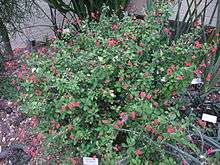Euphorbia milii var. splendens
Euphorbia milii var. splendens is a variety of the species Euphorbia milii.[1] Like the other varieties of E.milii (and, indeed, like many other plants in the spurge family Euphorbiaceae) E.m.var.splendens produces a milky latex that is an irritant poison. Under the name sijou (alternative spelling sijwu) the plant (known formerly to science as Euphorbia splendens) is considered to be sacred in the Bathouist religion of the Bodo people of Assam, West Bengal, Nagaland and Nepal - in which it symbolises the supreme deity, Bathoubwrai (Master of the Five Elements). This cultivation for ritual purposes of the sijou tree was particularly strong among the Bodo people (known also as Mech) of the Goalpara region. The plant does not often set seed, but is easy to propagate vegetatively; branches broken from an established plant root readily as cuttings. Families that follow Bathouism plant a sijou shrub at the northeast corner of their courtyard in an altar referred to as the sijousali. Bodo communities that follow Bathouism generally plant a sijou shrub/small tree in a piece of communally-owned land, which they fence with eighteen pairs of bamboo strips with five fastenings. Each pair symbolizes a divine couple consisting of a minor God and a minor Goddess. The Five Fastenings (bando) signify (counting from bottom to top) : birth, pain, death, marriage and peace/pleasure. The milestones on the path of life represented by the bottom three fastenings are those that one cannot escape; whereas those symbolised by the top two are not necessarily attained by all.[2]
| Euphorbia milii var. splendens | |
|---|---|
 | |
| Scientific classification | |
| Kingdom: | Plantae |
| Clade: | Tracheophytes |
| Clade: | Angiosperms |
| Clade: | Eudicots |
| Clade: | Rosids |
| Order: | Malpighiales |
| Family: | Euphorbiaceae |
| Genus: | Euphorbia |
| Species: | |
| Variety: | E. m. var. splendens |
| Trinomial name | |
| Euphorbia milii var. splendens (Bojer ex Hook.) Ursch & Leandri | |
| Synonyms | |
|
Euphorbia splendens Bojer ex Hook. | |
References
- (Bojer ex Hook.) Ursch & Leandri, Mém. Inst. Sci. Madagascar, Sér. B, Biol. Vég. 5: 148 (1954 publ. 1955).
- Endle, Sidney (1911). The Kacharis. London: Macmillan and Co.